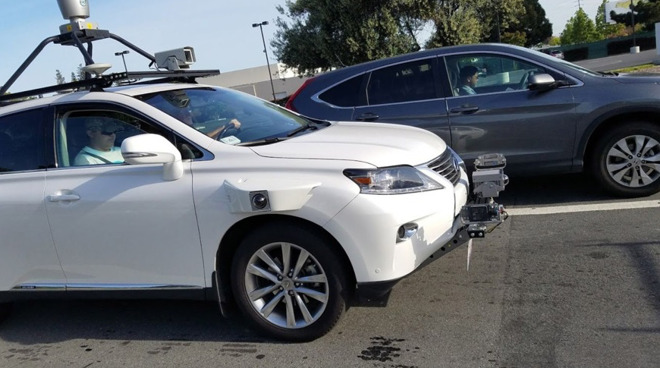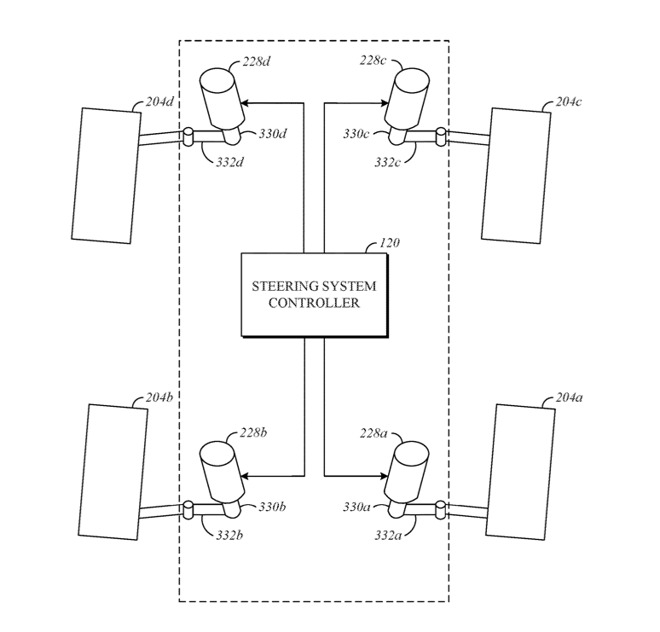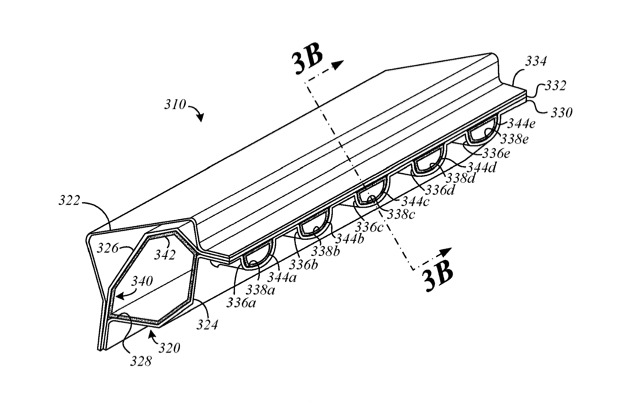Apple's automotive ambitions extend far beyond self-driving systems
For a product that Apple still hasn't officially admitted that it was working on, the "Apple Car" is getting a lot of research and development work, including steering, ventilation, and software-based self-adjusting sensors.

The sensors in "Apple Car" will be somewhat less conspicuous than those on this mapping vehicle
So that's which direction you're going, how comfortable you are, and how accurate the car's road sense is. Add these to the recent patents regarding cameras that identify landmarks, car doors, and automatically tinting roof glass.
"An autonomous vehicle includes numerous optical sensors configured to sense a surrounding environment around the vehicle," says Apple. "The optical sensors provide information regarding the environment to the vehicle such that the vehicle is spatially aware of the vehicle's surroundings in order to determine an appropriate action."

Projectors display a known pattern and then sensors compare their alignment to it
That makes sense, and it's also something we're used to seeing from Tesla cars. However, Apple is concerned with how these sensors perform over the long term.
"Over time, the vehicle may encounter various impacts that may disrupt positioning of the sensors, such as bumps in a road, vibrations from driving or sudden stoppage while driving," continues the patent. "These impacts can potentially cause the sensors to be out of alignment from original factory specifications. Unaligned or misaligned sensors can disrupt autonomy functions of the vehicle due to incorrect or misinterpreted data from the sensors."
One solution would be for Apple to reduce the recommended time, or miles driven, between services. But this is Apple and that won't do.
"Taking the vehicle into a service center for realignment of the sensors is inefficient and inconvenient for an owner of the vehicle," says the patent. "Relative calibration may improve the functionality of the sensors to detect the surrounding environment."
Apple's logic is that to align a sensor properly, you need precision equipment -- and you've already got that right there in the car. This patent is about leveraging the whole set of sensors in order to spot when one has gone out of alignment.
"Apple Car," then, may include "a projector configured to project a pattern on a target location," which the sensors then check out. "[One] or more sensors may also be configured to detect the pattern at the target location," and the car has a calibration system on board.
"[This] calibration system is configured to determine whether a particular sensor of the one or more sensors is out of alignment based on a relative position of the pattern as detected by the one or more sensors," says Apple. It will also then have the ability to fix the alignment and recheck it.
"Steer-by-wire system with multiple steering actuators," also newly-granted, is a patent regarding steering and especially when a driver allows the car itself to take control.

While not specifically stated, the patent includes the option for four-wheel drive
"Examples of vehicle actuators are propulsion actuators, braking actuators, steering actuators, and suspension actuators," explains Apple. "Steer-by-wire systems can eliminate or disconnect a physical connection between a steering wheel... and the road wheels."
Despite all of the advances in car steering systems, right up to power steering, it is still fundamentally the case that when you turn the wheel, you directly turn the car. With Apple's proposed system, it could be that the car recognizes you've turned the wheel, and then separately indirectly matches that movement.
That disconnect between your physical action and what the car does could be as jarring as the first time you use cruise control. However, it is only one of many options, and this patent is to do with the car switching between them.
"[One] control mode is a fully manual mode in which the human operator steers the vehicle using a physical connection that is established between the steering wheel and the roads wheels," says Apple. Others include "an automated control mode," where the car is doing the driving. Or "some vehicles can also be operated in a remote control mode."
What the patent is concerned with is less the car taking over control and leaving you to spin the wheel uselessly, and rather exactly what happens when you reassert control. It's similar to how cruise control will switch off when you lightly touch the gas pedal, but the system can't suddenly slow down to the speed that light touch would suggest.
"Body structure ventilation," is about making a strong, lightweight, and well-ventilated car chassis. Every car maker aims to do exactly this, but every car maker is constrained by certain engineering requirements.

How Apple plans to make more room for ventilation in a car body by carefully designing and shaping support structures
"Typical vehicle body structures include structural rails, sills, and pillars that support portions of the vehicle, such as a roof and a door," says Apple. "As an example, most vehicles include structural pillars referred to as 'A-pillars' that are positioned adjacent to a windshield and forward of a front door of the vehicle."
There are also B pillars, between the front and rear doors, plus C-pillars that are "positioned rearward of the rear door of the vehicle." All of these, plus "roof rails [and] door sills function to support the roof and the doors of the vehicle" and each has to be made to "satisfy certain strength requirements."
Add to this that cars have to include features such as safety airbags, and the space in a car's chassis is tight. Apple argues that this constraint is what prevents adequate ventilation around the vehicle.
That's as much about keeping the car itself cool, as it is about doing the same for the driver and the passenger. Under Apple's proposals, the space in the chassis for a heating duct is maximized, while "vehicle body structure [still] supports portions of the vehicle."
Apple proposes creating the structure from, in part, a "flanged portion" includes indentations that "form passageways... and a duct." Ultimately, it's about using the space available more effectively, and creating more such space where possible by the design of the individual supporting elements of the chassis.
These three patents are credited to a total of seven people. The sole inventor listed on the sensor alignment one, Micah P. Kalscheur, has previously worked on patents to do with Apple's Face ID technology.

The sensors in "Apple Car" will be somewhat less conspicuous than those on this mapping vehicle
So that's which direction you're going, how comfortable you are, and how accurate the car's road sense is. Add these to the recent patents regarding cameras that identify landmarks, car doors, and automatically tinting roof glass.
Self-adjusting sensors
"Multi-sensor real-time alignment and calibration," one of the newly granted patents, is to do with "real-time alignment and calibration" of multiple sensors that the "Apple Car" will use."An autonomous vehicle includes numerous optical sensors configured to sense a surrounding environment around the vehicle," says Apple. "The optical sensors provide information regarding the environment to the vehicle such that the vehicle is spatially aware of the vehicle's surroundings in order to determine an appropriate action."

Projectors display a known pattern and then sensors compare their alignment to it
That makes sense, and it's also something we're used to seeing from Tesla cars. However, Apple is concerned with how these sensors perform over the long term.
"Over time, the vehicle may encounter various impacts that may disrupt positioning of the sensors, such as bumps in a road, vibrations from driving or sudden stoppage while driving," continues the patent. "These impacts can potentially cause the sensors to be out of alignment from original factory specifications. Unaligned or misaligned sensors can disrupt autonomy functions of the vehicle due to incorrect or misinterpreted data from the sensors."
One solution would be for Apple to reduce the recommended time, or miles driven, between services. But this is Apple and that won't do.
"Taking the vehicle into a service center for realignment of the sensors is inefficient and inconvenient for an owner of the vehicle," says the patent. "Relative calibration may improve the functionality of the sensors to detect the surrounding environment."
Apple's logic is that to align a sensor properly, you need precision equipment -- and you've already got that right there in the car. This patent is about leveraging the whole set of sensors in order to spot when one has gone out of alignment.
"Apple Car," then, may include "a projector configured to project a pattern on a target location," which the sensors then check out. "[One] or more sensors may also be configured to detect the pattern at the target location," and the car has a calibration system on board.
"[This] calibration system is configured to determine whether a particular sensor of the one or more sensors is out of alignment based on a relative position of the pattern as detected by the one or more sensors," says Apple. It will also then have the ability to fix the alignment and recheck it.
Steering "Apple Car"
The sensors that need alignment "may include one or more actuators," says Apple. This is the term used for any number of different elements in the car, elements that operate mechanisms or physically move. They include ones specifically for steering."Steer-by-wire system with multiple steering actuators," also newly-granted, is a patent regarding steering and especially when a driver allows the car itself to take control.

While not specifically stated, the patent includes the option for four-wheel drive
"Examples of vehicle actuators are propulsion actuators, braking actuators, steering actuators, and suspension actuators," explains Apple. "Steer-by-wire systems can eliminate or disconnect a physical connection between a steering wheel... and the road wheels."
Despite all of the advances in car steering systems, right up to power steering, it is still fundamentally the case that when you turn the wheel, you directly turn the car. With Apple's proposed system, it could be that the car recognizes you've turned the wheel, and then separately indirectly matches that movement.
That disconnect between your physical action and what the car does could be as jarring as the first time you use cruise control. However, it is only one of many options, and this patent is to do with the car switching between them.
"[One] control mode is a fully manual mode in which the human operator steers the vehicle using a physical connection that is established between the steering wheel and the roads wheels," says Apple. Others include "an automated control mode," where the car is doing the driving. Or "some vehicles can also be operated in a remote control mode."
What the patent is concerned with is less the car taking over control and leaving you to spin the wheel uselessly, and rather exactly what happens when you reassert control. It's similar to how cruise control will switch off when you lightly touch the gas pedal, but the system can't suddenly slow down to the speed that light touch would suggest.
Riding in comfort
Whether you're in control of the car, or the car itself is, you've still got to be sitting there for a long time. The third of the newly granted patents is concerned with making your environment as comfortable as possible."Body structure ventilation," is about making a strong, lightweight, and well-ventilated car chassis. Every car maker aims to do exactly this, but every car maker is constrained by certain engineering requirements.

How Apple plans to make more room for ventilation in a car body by carefully designing and shaping support structures
"Typical vehicle body structures include structural rails, sills, and pillars that support portions of the vehicle, such as a roof and a door," says Apple. "As an example, most vehicles include structural pillars referred to as 'A-pillars' that are positioned adjacent to a windshield and forward of a front door of the vehicle."
There are also B pillars, between the front and rear doors, plus C-pillars that are "positioned rearward of the rear door of the vehicle." All of these, plus "roof rails [and] door sills function to support the roof and the doors of the vehicle" and each has to be made to "satisfy certain strength requirements."
Add to this that cars have to include features such as safety airbags, and the space in a car's chassis is tight. Apple argues that this constraint is what prevents adequate ventilation around the vehicle.
That's as much about keeping the car itself cool, as it is about doing the same for the driver and the passenger. Under Apple's proposals, the space in the chassis for a heating duct is maximized, while "vehicle body structure [still] supports portions of the vehicle."
Apple proposes creating the structure from, in part, a "flanged portion" includes indentations that "form passageways... and a duct." Ultimately, it's about using the space available more effectively, and creating more such space where possible by the design of the individual supporting elements of the chassis.
These three patents are credited to a total of seven people. The sole inventor listed on the sensor alignment one, Micah P. Kalscheur, has previously worked on patents to do with Apple's Face ID technology.


Comments
Well, one thing we know about Apple is that it's tighter than Kylie's jeans when it comes to spending money. They've spent millions, possibly billions on R&D around cars, so I'd be surprised if they didn't come up with a vehicle at the end of it.
The thing is, since the COVID mess, the world is now working at home and cycling everywhere so we might just end up with an Apple Cycle
What car company is worthy of Apple's innovations and what car company does Apple need?
Why can't Apple do what Tesla is doing? Even Elon Musk said Apple will be a direct competitor and it seems it's the only company he takes seriously as a competitor. I have no idea why people doubt Apple when they're creating something.
With that said, the only company that makes sense in my kind would be a McLaren. A company with great designs. Tesla is leading the electric vehicle revolution but even they have a ton of problems. Their sedans are not innovative at all, they're just electric.
I'm hoping they offer a cheap "SE" alongside a super premium vehicle.
I also like the idea of Apple going into the bar business. They already have the genius bar--and tons of young adults milling about (pre-pandemic)--they just need to get liquor licenses for their retail stores.
Beside always asking for more funding from investors?
Tesla's P/E is 1080, Apple's is 35. Tesla ROE is 4%, Apple is 70%. Rating on Tesla quality is poor, Apple is at the top for quality.
One other thing to consider is the market for an Apple Vehicle; I'm avoiding "car" because that's an assumption. And the other assumption is Apple would sell in the US.
If you remember, states passed many laws to prevent Tesla from selling directly to consumers -- legacy car manufacturers, suppliers, auto-repair shops, dealers hated the idea of having to compete with Tesla so they did what lots of money always does -- buy legislators to create barriers to competition.
Why would Apple want to run up against legal barriers thrown their way. Now, China, India, with their manufacturing prowess and at least publicly taking the lead on climate change, while the US does everything it can to claim it's a hoax.
In fact, plenty of states are changing these laws specifically to allow Tesla to sell directly. I don't see why Apple wouldn't be just as successful (or more) in getting exceptions or getting those law changed. Or worst case, Apple simply sells their cars through franchised car dealerships. That works find for premiere brands from Porsche to Lexus to BMW.
The time limit on these patents would be 20 years, but it's typical that another patent to be applied a few years down the road based on the original with only a couple of claims added if Apple decides it's a particularly worthy one. IMO the 20 year life on an implementation isn't really limiting to the owner much of the time and of little concern.